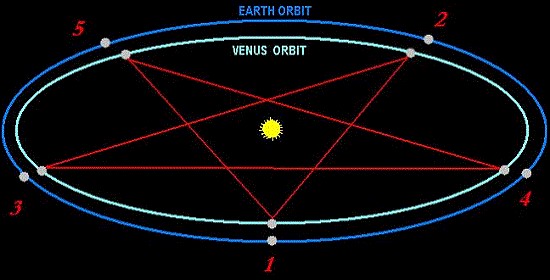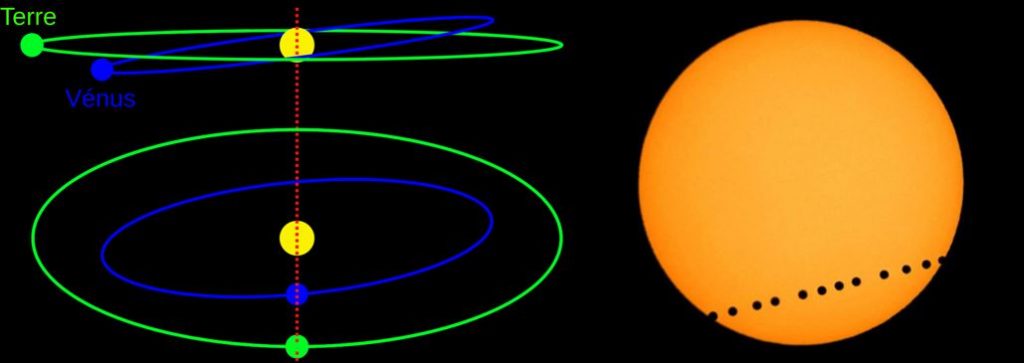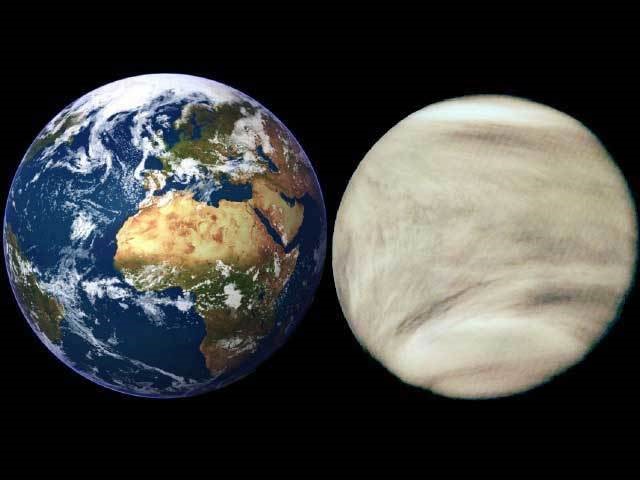The Earth and Venus are a particular couple within the solar system with a lot in common.
Orbital Neighbor
Compared in terms of average distance at the time of conjunction, Venus and Earth are the closest planets to the solar system with a gap of 41.4 million kilometers, compared to 50.3 between Venus and Mercury where 78.3 between Earth and Mars. Moreover, their two orbits are characterized by exceptional circularity. Indeed Venus is the planet with the lowest eccentricity (0.0068) and the Earth the third (0.0167) with only Neptune (0.0086) to separate them. However, in terms of orbital inclination, Venus is the second planet with orbital inclination (3.39 degrees) compared to the ecliptic behind Mercury (7 degrees), but this is mainly due to the small distance with the sun that increases the value of the angle for the same deviation.
Because of their proximity, the two planets evolve at close velocities, which lengthens the time it takes for Venus to catch up with Earth. Finally, Venus has the second longest synodic period (seen from Earth) with 584 Earthday behind Mars (780j), which may be further away, moves less quickly. This period corresponds to almost 1.6 Earth years, i.e. the Earth is 1 full lap and three-fifths of a second while Venus travels 2 complete towers and three-fifths of a third. These 3/5s create a resonance effect because the Earth and Venus find almost in the same place every 5 synodic periods, i.e. 8 years. If we connect the position of the Earth or Venus to each conjunction during these 8 years, we get a 5-branched star called Venus Pentacle.

The inclination shift between the two planets melts that at most conjunctions, Venus passes (view of the earth) above or below the sun. The transits (passage of Venus in the solar disk during an alignment) of Venus are therefore particularly rare because only occur when a conjunction occurs near one of the two nodes.
If the orbital resonance were perfect, the 5 conjunction points would be fixed and there would be a transit every 8 years (if a conjunction was at a node) or never. However, since the Earth-Venus resonance is not perfect, Venus’ pentacle shifts a few degrees every 8 years. This lag causes one of the branches to pass near a node from time to time and create a transit. The lag is so small, that 8 years later, the branch has not shifted enough to get out of the solar disk and thus creates a second transit.
The current rate of transits (valid from 1518 to 2846) follows a sequence 8/105.5/8/121.5, i.e. a first transit, followed 8 years later by a second at the same node (thus almost the same date), then 105 years and 6 months later, a transit at the opposite node (hence the 6-month lag) followed by the second transit 8 years later, and finally 121 years and 6 months before reviewing a conjunction at the first node. The last transits took place in June (8 and 6) 2004 and 2012 respectively, so the next ones will take place in December 2117 and 2125.

Physical lookalike
In terms of size, the two planets are also very close with a radius at the equator of 6,378km for Earth and 6,052km for Venus (compared to 3,289 km for Mars), making them the two largest solid bodies in the solar system. Moreover, because of their proximity to distance, the two planets have developed in the same portion of the protoplanetary disk and it can be inferred (and the scientific data collected to date go in this direction) that the two planets are made up of the same basic elements.
From what is known of the composition of Venus, its surface is mainly volcanic and very similar to the Earth’s ocean floor. Their density are therefore close and seen as their size too, they have a similar mass because, if we take as a reference the mass of the Earth, Venus makes 81.5%, compared to Mars makes 10.7%. The surface gravity is therefore close with by definition 1g (9.81m/s) on Earth and 0.905g on Venus versus 0.379g on Mars.

Venus and Earth are the only solid bodies in the solar system with an important atmosphere with Titan (a moon of Saturn). This atmosphere allows for great thermal consistency by spreading heat over the entire surface. On Earth, the difference between the record low temperature (-89.2°C, polar night at Vostok base, in the heart of the Antarctic) and high (56.7°C on a summer day in Death Valley, USA) is 150 degrees Celsius. On Venus, the atmosphere is even more massive, so the temperature never varies by more than 30 degrees Celsius around the average temperature of 462 degrees Celsius, whether day or night, at the equator or at the pole.